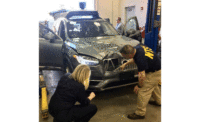DOT starts rulemaking process for vehicle-to-vehicle communications
 The U.S. Department of Transportation's (DOT) National Highway Traffic Safety Administration (NHTSA) Monday released an advance notice of proposed rulemaking (ANPRM) and a supporting comprehensive research report on vehicle-to-vehicle (V2V) communications technology. The report will include analysis of the Department's research findings in several key areas including technical feasibility, privacy and security, and preliminary estimates on costs and safety benefits, while the ANPRM seeks public input on these findings to support the Department’s regulatory work to eventually require V2V devices in new light vehicles.
The U.S. Department of Transportation's (DOT) National Highway Traffic Safety Administration (NHTSA) Monday released an advance notice of proposed rulemaking (ANPRM) and a supporting comprehensive research report on vehicle-to-vehicle (V2V) communications technology. The report will include analysis of the Department's research findings in several key areas including technical feasibility, privacy and security, and preliminary estimates on costs and safety benefits, while the ANPRM seeks public input on these findings to support the Department’s regulatory work to eventually require V2V devices in new light vehicles.
"Safety is our top priority, and V2V technology represents the next great advance in saving lives," said U.S. Transportation Secretary Anthony Foxx. "This technology could move us from helping people survive crashes to helping them avoid crashes altogether – saving lives, saving money and even saving fuel thanks to the widespread benefits it offers."
Left turn and intersection apps
The report includes preliminary estimates of safety benefits that show two safety applications - Left Turn Assist (LTA) and Intersection Movement Assist (IMA) – could prevent up to 592,000 crashes and save 1,083 lives saved per year. Put another way, V2V technology could help drivers avoid more than half of these types of crashes that would otherwise occur by providing advance warning. LTA warns drivers not to turn left in front of another vehicle traveling in the opposite direction and IMA warns them if it is not safe to enter an intersection due to a high probability of colliding with one or more vehicles. Additional applications could also help drivers avoid imminent danger through forward collision, blind spot, do not pass, and stop light/stop sign warnings.
The accompanying ANPRM will help DOT and NHTSA gather significant input from the public and stakeholders as NHTSA works to deliver a Notice of Proposed Rulemaking by 2016.
Environmental benefits possible
V2V technology has the potential to be fused with existing vehicle safety features to further improve the effectiveness of many crash avoidance safety systems currently being developed and implemented in the vehicle fleet and serve as a building block for a driverless vehicle. Vehicles equipped with V2V technology could also enable the development of a wide range of mobility and environmental benefits based on vehicle-to-infrastructure applications and other V2V applications that can enhance traffic flow in many ways. V2V technology does not involve collecting or exchanging personal information or tracking drivers or their vehicles.
The information sent between vehicles does not identify those vehicles, but merely contains basic safety data. In fact, the system as contemplated contains several layers of security and privacy protection to ensure that vehicles can rely on messages sent from other vehicles.
Read "Vehicle-to-Vehicle Communications: Readiness of V2V Technology for Application" research report
The ANPRM will be available at the Regulations.gov docket (NHTSA-2014-0022) and members of the public will have the opportunity to comment for 60 days
Go to NHTSA's V2V Communications site for more information
Looking for a reprint of this article?
From high-res PDFs to custom plaques, order your copy today!







.jpg?t=1721257160)
